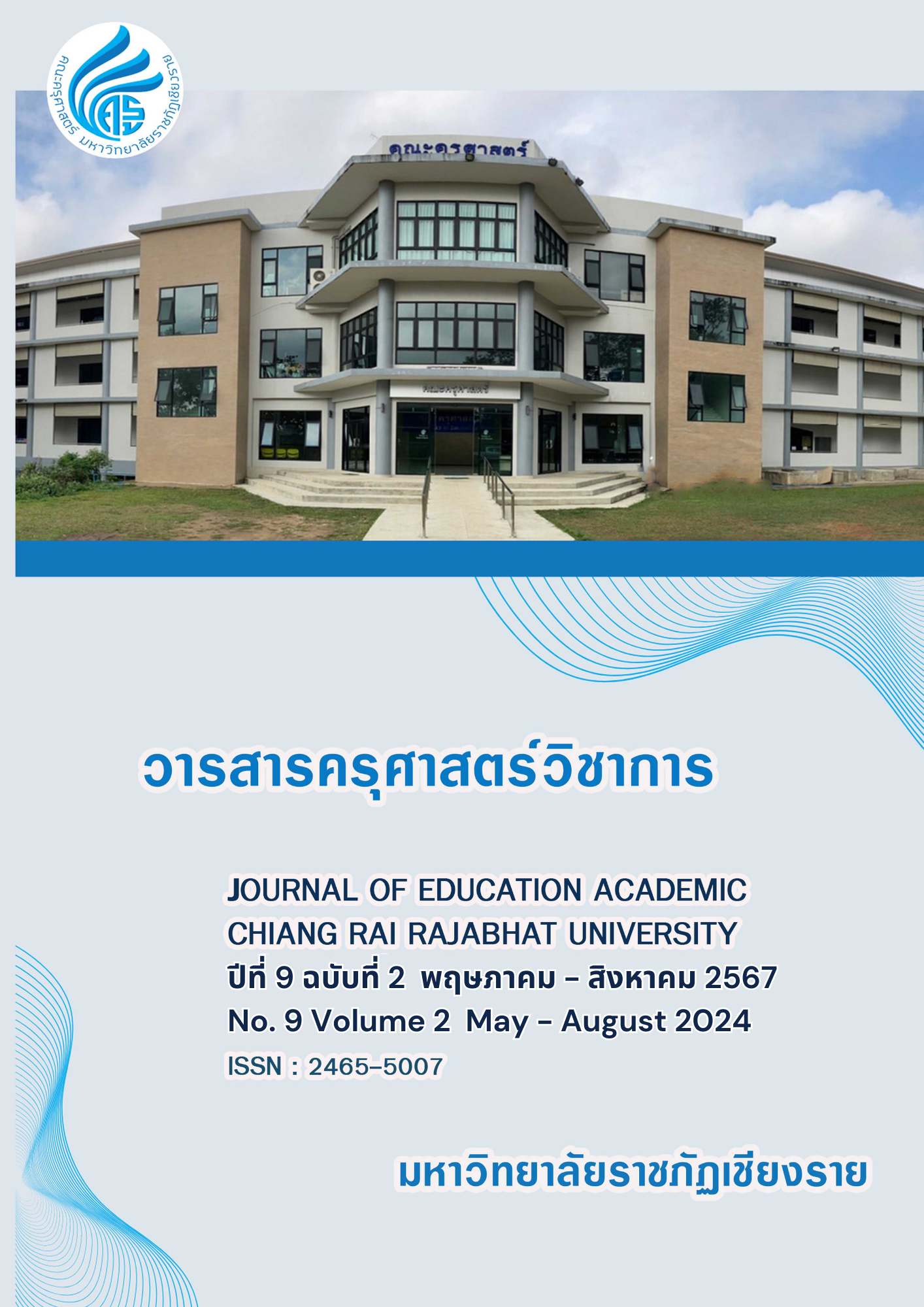Development of Mathematical Problem-Solving Ability on Prism and Cylindrical for Grade 8 Students using GeoGebra to Organize 4 MAT Learning Activities
Keywords:
4 MAT Learning, Mathematics Problem Solving, GeoGebra Program, Grade 8 StudentsAbstract
This research is action research. The objective was to develop the ability to solve mathematical problems on Prism and Cylindrical for grade 8 students using GeoGebra to organize 4 MAT learning activities. The sample used in the research was 25 students in grade 8 who are studying in Semester 1 of the academic year 2023 at Dongmoon Wittayakhom School, Nong Kung Si District, Kalasin Province. The data were analyzed using averages, standard deviations, and percentages. Research instruments include: 1)Prism and Cylindrical Mathematics Learning Management Plan for Math students using GeoGebra to organize 4 MAT learning activities 2) End-cycle math problem-solving ability test. The statistics used to analyze data include percentage, average and standard deviation
The results showed that the students in the sample group had increased scores for the ability to solve problems after the learning using GeoGebra to organize 4 MAT learning activities. In the first operating cycle, 18 students passed the 70% standard, namely 72%. In the second operating cycle, 22 students have passed the 70% standard, accounting for 88%, and in the third operating cycle, 24 students have passed the 70% standard, accounting for 96%.
References
กระทรวงศึกษาธิการ. (2560). มาตรฐานการเรียนรูและตัวชี้วัดกลุมสาระการเรียนรูคณิตศาสตร์ วิทยาศาสตร์ และสาระภูมิศาสตร์ในกลุมสาระการเรียนรูสังคมศึกษา ศาสนา และวัฒนธรรม (ฉบับปรับปรุง พ.ศ. 2560) ตามหลักสูตรแกนกลางการศึกษาขั้นพื้นฐาน พุทธศักราช 2551. (พิมพ์ครั้งที่ 1). กรุงเทพฯ: โรงพิมพ์ชุมนุมสหกรณ์การเกษตรแห่งประเทศไทย จำกัด.
ณรงค์ ปุณนิ่ม. (2013). ครูมืออาชีพ. สืบค้นเมื่อ 23 กรกฎาคม 2018. https://ajnawarut. files. เวิร์ดเพรส.คอม
ดาวเรือง บุตรทรัพย์. (2560). การใช้โปรแกรม GeoGebra ประกอบการจัดกิจกรรมการเรียนรู้ตามรูปแบบ4MAT เพื่อพัฒนาผลสัมฤทธิ์ทางการเรียน เรื่องการทดสอบสมมติฐาน. (พิมพ์ครั้งที่12).
ทิศนา แขมมณี. (2564). ศาสตร์การสอนองค์ความรู้เพื่อการจัดกระบวนการเรียนรู้ที่มีประสิทธิภาพ. กรุงเทพ:สำนักพิมพ์จุฬาลงกรณ์มหวิทยาลัย.
บุญชม ศรีสะอาด. (2545). การวิจัยเบื้องต้น (พิมพ์ครั้งที่ 7). กรุงเทพฯ: สุวีริยาสาส์น.
______________. (2553). การวิจัยเบื้องต้น (พิมพ์ครั้งที่ 8). กรุงเทพฯ: สุวีริยสาส์น.
ประสาท เนืองเฉลิม. (2563). วิจัยการเรียนการสอน (พิมพ์ครั้งที่ 4). กรุงเทพฯ: สำนักพิมพ์จุฬาลงกรณ์มหาวิทยาลัย.
มลฤดี มณีล้ำ. และไพรินทร์ สุวรรณศรี. (2564). การพัฒนาชุดกิจกรรมการเรียนรู้แบบพลวัต GeoGebra
เรื่อง ปริซึมเพื่อเพิ่มความคิดเชิงเรขาคณิตสามมิติ. วารสารวิทยาศาสตร์และวิทยาศาสตร์ศึกษา (JSSE). 4(2), 262.
วนิดา ศรีหา. ปวีณา ขันธ์ศิลา. และสุวรรณวัฒน์ เทียนยุทธกุล. (2023). ผลการจัดการเรียนรู้โดยใช้โปรแกรมGeoGebra เรื่อง พื้นที่ผิวและปริมาตรของนักเรียนชั้นมัธยมศึกษาปีที่ 2. วารสารราชภัฏสุรินทร์วิชาการ. 1(4), 1–14.
สถาบันทดสอบทางการศึกษาแห่งชาติ. (2566). สรุปผลการทดสอบทางการศึกษาระดับชาติขั้นพื้นฐาน (O-NET) ระดับชั้นมัธยมศึกษาปีที่ 3 ปีการศึกษา 2565. สืบค้นเมื่อ 10 พฤศจิกายน 2566. เข้าถึงได้จาก http://www.newonetresult.niets.or.th/AnnouncementWeb/PDF/SummaryONETM3_2565.
สถาบันส่งเสริมการสอนวิทยาศาสตร์และเทคโนโลยี. (2551). ตัวอย่างการประเมินผลวิทยาศาสตร์นานาชาติ: PISA และ TIMSS. กรุงเทพฯ: อรุณการพิมพ์.
สุวร กาญจนยูร. (2533). เทคนิคการสอนคณิตศาสตร์ระดับประถมศึกษา เล่ม 3. กรุงเทพฯ: ไทยวัฒนาพานิช.
สุวิทย์ มูลคํา. และอรทัย มูลคํา. (2552). 21 วิธีจัดการเรียนรู้เพื่อพัฒนากระบวนการคิด. พิมพ์ครั้งที่ 8. กรุงเทพฯ: ภาพพิมพ์.
Hohenwarter, M., et al. (2018). Putting the world's leading dynamic mathematics software and materials in the hands of students and teachers everywhere. Retrieved from: https://www.geogebra.org/about?lang=eng [accessed 30 August 2018].
Hutkemri, L., & Akmar, S. (2016). Effectiveness of GeoGebra on academic and conceptual knowledge: role of students’ procedural knowledge as a mediator. New Educational Review, 44(2), 153-164.
Kemmis, S and Mc Taggart, R. (1998). The Action Research Planer. 3rd ed. Victoria: Deakib University.45.
Polyiem, P., Sonsupap, K., & Education, M. U. T. F. of. (2021). Development of Problem-Solving Ability Using Deductive Teaching Method with STAR Strategy in Mathayomsuksa 5 Students (Thesis, Mahasarakham University). Mahasarakham University. สืบค้นเมื่อ 10 พฤศจิกายน 2566. เข้าถึงได้จาก http://202.28.34.124:8080/jspui/handle/123456789/1331.
Richardson, S. E., & Koyunkaya, M. Y. (2017). Fostering students' development of the concept of angles using technology. Australian Primary Mathematics Classroom. 22(1), 13-20.
Thanida Ruangtrakun. and Supotch Chaiyasang. (2019). Using 4MAT Teaching Model to Enhance Students’ Achievement and to Maintain Retention in Mathematics. Veridian E-Journal,Silpakorn University (Humanities, Social Sciences and Arts). 12(6), 1248–1261.
Zengin, Y., Furkan, H. and Kutluca, T. (2012). The effect of dynamic mathematics software geogebra on student achievement in teaching of trigonometry. Procedia - Social and Behavioral Sciences. 31(2011), 183–187. https://doi.org/10.1016/j.sbspro.2011.12.038.
Downloads
Published
Issue
Section
License
Copyright (c) 2024 Journal of Education Academic Chiang Rai Rajabhat University

This work is licensed under a Creative Commons Attribution-NonCommercial-NoDerivatives 4.0 International License.






